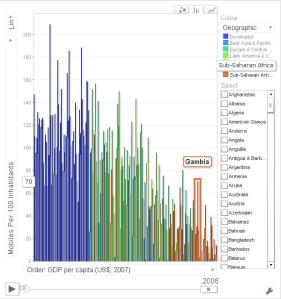How are ICT diffusion rates changing over time in different parts of the world? The graphs below present ITU statistics for mobile, internet and broadband, dividing countries into quintiles by GDP per capita levels, and weighting the calculated averages within each quintile by population. They extend earlier data visualisations using Google motion chart for mobile phone and broadband penetration.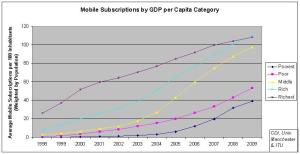
– Mobile: a real sense of catch-up by the “rich” and “middle-income” countries during the mid-2000s, the former now having higher subscription rates than the “richest” countries due largely to the USA’s sub-100-per-100 statistics. Catch-up is only just starting to happen for the poorer countries, and there’s a reminder that “mobiles are everywhere” isn’t true yet: e.g. we’ve all heard of Pakistan’s amazing growth rates but the next largest country in the bottom category is Ethiopia whose 80m citizens register less than five subscriptions per 100 people. For fans of diffusion theory, some clear S-curve shapes on view, though a slightly worrisome dip in growth rates for the poorest countries from ’08 to ’09. (For notes on converting mobile subscription rates to actual ownership and use rates in developing countries: see this earlier blog entry.)
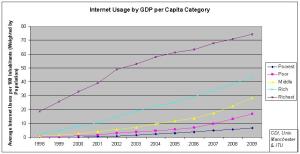 – Internet: still a significant gap between the richest countries and all the rest, which have a mix of larger-country stars (VietNam, China) that punch above their category averages, and dogs (South Africa, India) that fall well below. Due to spillover effects – e.g. an Internet user passing on web-based information to a non-user – the impact of the Internet is well above what these raw figures indicate. And poor/middle-income countries will pass the 50 users per 100 marker in just a few years. Growth rates in the poorest countries are strong – around 25% per year – but their low base means progress is slow.
– Internet: still a significant gap between the richest countries and all the rest, which have a mix of larger-country stars (VietNam, China) that punch above their category averages, and dogs (South Africa, India) that fall well below. Due to spillover effects – e.g. an Internet user passing on web-based information to a non-user – the impact of the Internet is well above what these raw figures indicate. And poor/middle-income countries will pass the 50 users per 100 marker in just a few years. Growth rates in the poorest countries are strong – around 25% per year – but their low base means progress is slow.
 – Broadband: if the Internet figures are a little salutary, then the broadband stats are more so, with the poorest countries barely figuring. Mobiles are helping to create Development 2.0 – the ICT-enabled transformation of development processes and structures, but broadband will also be key, and it looks a very long way off for the world’s poor. (Note poor countries average above middle-income due to China’s aggressive broadband roll-out policy, though are held back by India’s pitiful penetration rates of roughly two-thirds of a subscription per 100 people. Middle-income countries look likely to overtake in the next year or so.)
– Broadband: if the Internet figures are a little salutary, then the broadband stats are more so, with the poorest countries barely figuring. Mobiles are helping to create Development 2.0 – the ICT-enabled transformation of development processes and structures, but broadband will also be key, and it looks a very long way off for the world’s poor. (Note poor countries average above middle-income due to China’s aggressive broadband roll-out policy, though are held back by India’s pitiful penetration rates of roughly two-thirds of a subscription per 100 people. Middle-income countries look likely to overtake in the next year or so.)
Global Digital Gap and Digital Lag
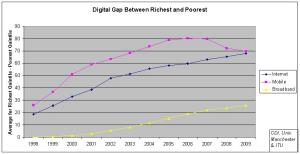 One way to summarise the situation is to look at the difference between the poorest and richest quintile countries. As the graph shows, the “digital gap” between average penetration rates has grown and grown during the 2000s for Internet and broadband. For mobile it began to close from 2006 onwards, but still remains very high.
One way to summarise the situation is to look at the difference between the poorest and richest quintile countries. As the graph shows, the “digital gap” between average penetration rates has grown and grown during the 2000s for Internet and broadband. For mobile it began to close from 2006 onwards, but still remains very high.
You can also measure “digital lag“: the time gap between a given average ICT penetration level in the poorest countries, and the year that was achieved in the richest countries.
Current digital lag is just under 10 years for mobile, and something like 14-15 years for Internet. For broadband, it’s just over 10 years but the figures are so low that this may not be meaningful.
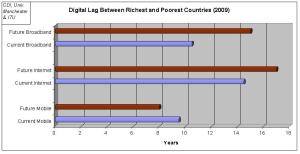 Future digital lag can be calculated by projecting growth in the poorest countries, assuming current growth rates (averaged 2004-2009) continue. For mobile, it will be 2011 before the poorest countries reach the 75 subscriptions per 100 level that the richest countries were at in 2004; a digital lag of 7 years (though that rises to 2013 and 9 years if you extrapolate from just 2008-to-2009 growth rates).
Future digital lag can be calculated by projecting growth in the poorest countries, assuming current growth rates (averaged 2004-2009) continue. For mobile, it will be 2011 before the poorest countries reach the 75 subscriptions per 100 level that the richest countries were at in 2004; a digital lag of 7 years (though that rises to 2013 and 9 years if you extrapolate from just 2008-to-2009 growth rates).
For Internet, it will be 2019 before the poorest countries reach the 50 users per 100 level that the richest countries were at in 2002; a digital lag of 17 years. For broadband, it will be 2020 before the poorest countries reach the 15 users per 100 level that the richest countries were at in 2005; a digital lag of 15 years (but with a wide margin for error, and calculated only on 2008-to-2009 growth rates). Put another way, there are no signs yet of the digital lag for Internet or broadband closing over time, and not much evidence for the idea that digital lag is shortening with each new ICT innovation.
I’m sure there are other conclusions to be drawn from the data – do please go ahead. All of the original data is available from the following spreadsheet: https://docs.google.com/leaf?id=0B-14eY3gwnmGYjVkYjIxYTQtMjQxNy00OTIxLWFlN2YtNDIwZWYzYWZlZjVk&hl=en_GB [you’ll need to log in to Google in order to guarantee access]

